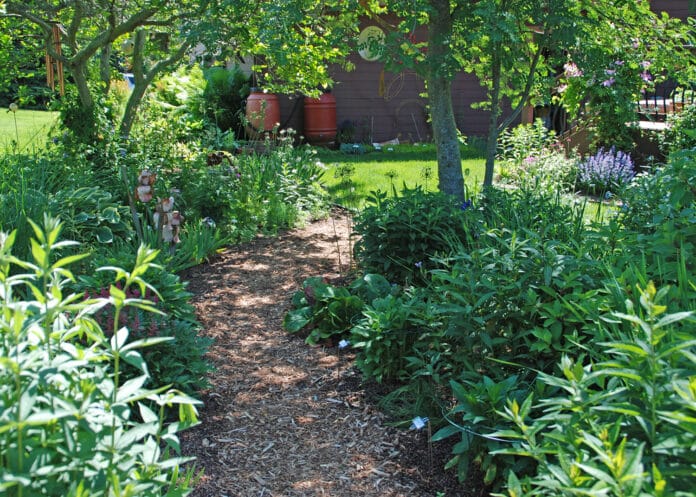
Keep your garden looking its best and reduce your workload by enlisting practices that provide multiple benefits. Your garden will flourish and you’ll have more time to enjoy its beauty.
Put your yard waste to work in your garden. You’ll save time hauling plant debris to the recycling center and money spent buying bagged material. Use shredded leaves, evergreen needles, herbicide-free grass clippings or other pest- and weed-free organic material as mulch. Spread a one to two-inch layer of these materials over the soil around annual and perennial flowers and vegetables.
Use woodchips and shredded bark to mulch pathways, trees, and shrubs. Consider joining forces with your neighbors, renting a chipper, and turning brush into mulch for your landscape. Maintain a two- to three-inch layer of mulch around these plants. And keep the mulch away from tree trunks and the crowns of the plants.
Organic mulch helps conserve moisture, reduce weeds, and improve the soil as it breaks down. So, you get multiple benefits from this one task while burning a few calories and strengthening your muscles.
Water plants thoroughly and less frequently whenever you irrigate the garden. This encourages deep roots, making your plants more drought tolerant and pest resistant. Water early in the day to reduce water lost to evaporation. And consider using drip irrigation or soaker hoses to deliver water right to the plant roots where it is needed.
Check container gardens daily. Water thoroughly until the excess water runs out the bottom. Or enlist the help of one of the many container irrigation systems. Consider using a slow release fertilizer when needed to keep plants thriving with less effort. These types of fertilizers provide a slow, steady release of nutrients for balanced growth without sacrificing flowers or burning drought stressed plants.
Don’t forget your trees and shrubs. Proper watering will also improve their health. Water new plantings and moisture lovers whenever the top few inches of soil are dry. Even established trees and shrubs need a helping hand during extended periods of drought. Always water thoroughly to encourage deep, drought-resistant roots.
Keep mowing your lawn as long as your grass is actively growing. Mow high since taller grass is better able to out compete the weeds and forms deeper roots, making it more drought tolerant. Minimize the stress by removing no more than a third of the total grass height each time you mow.
Always use a sharp mower blade. Sharp blades cut more efficiently, saving you time whenever you mow. You’ll consume 22% less fuel and the lawn will use up to 30% less water when using sharp blades. Plus, the clean cut will be less noticeable and the wound will close quickly, helping you grow a healthy, better-looking lawn.
Be sure to leave grass clippings on the lawn. They add nutrients, moisture, and organic matter to the soil. A season’s worth of clippings is equal to one fertilizer application. So every time you mow you are fertilizing the lawn and improving the soil.
Finish every garden chore with a bit of cleanup. Sweep clippings, plant debris and fertilizer off walks, drives and patios, so it won’t wash into storm sewers. Keeping plant debris out of our waterways is good for us and the environment.














